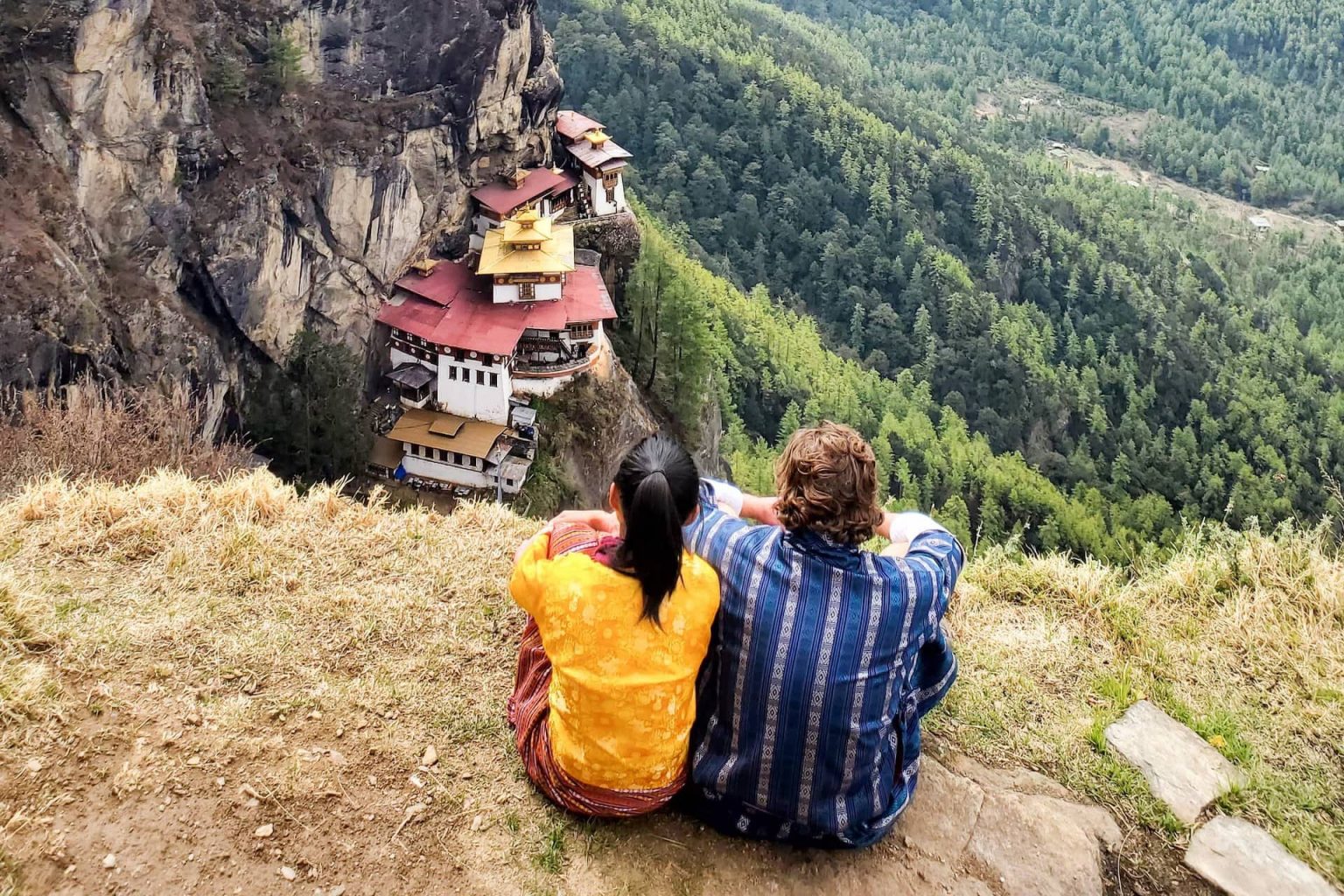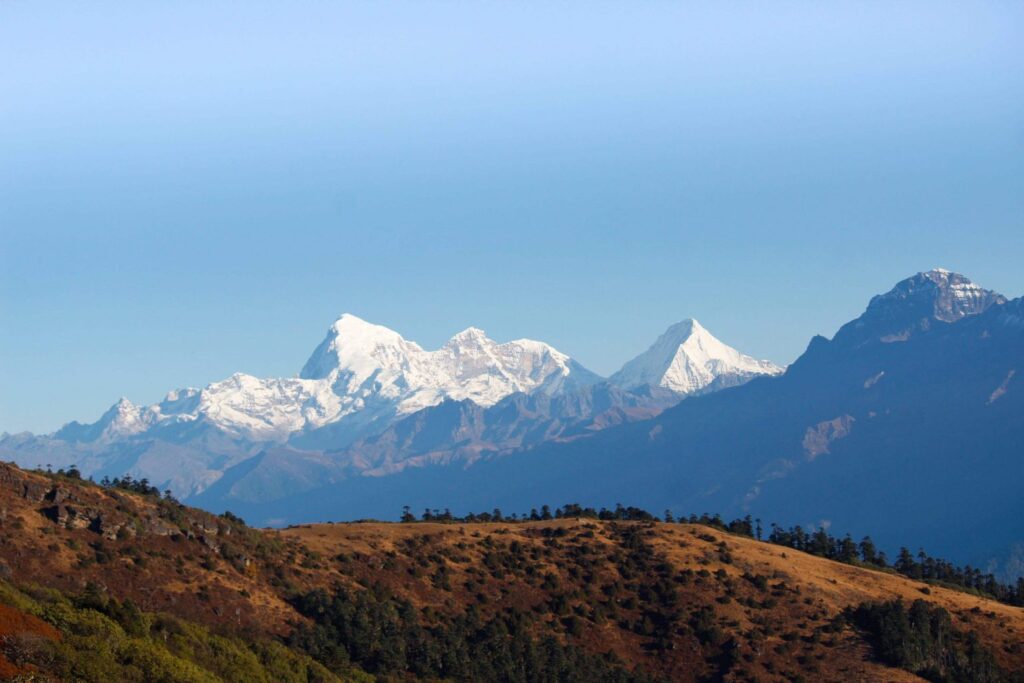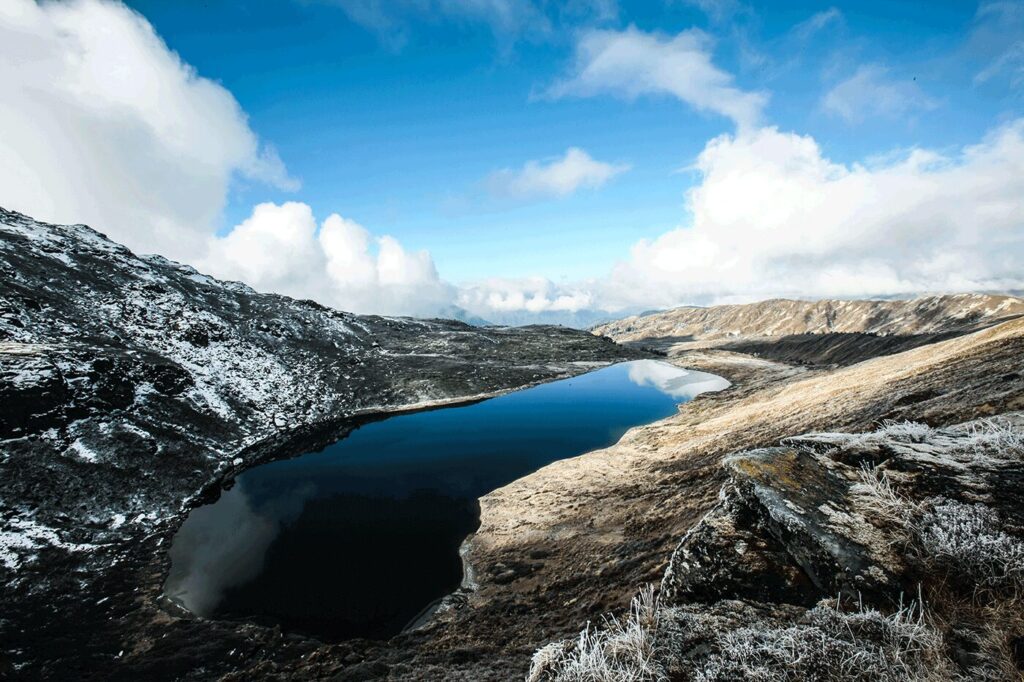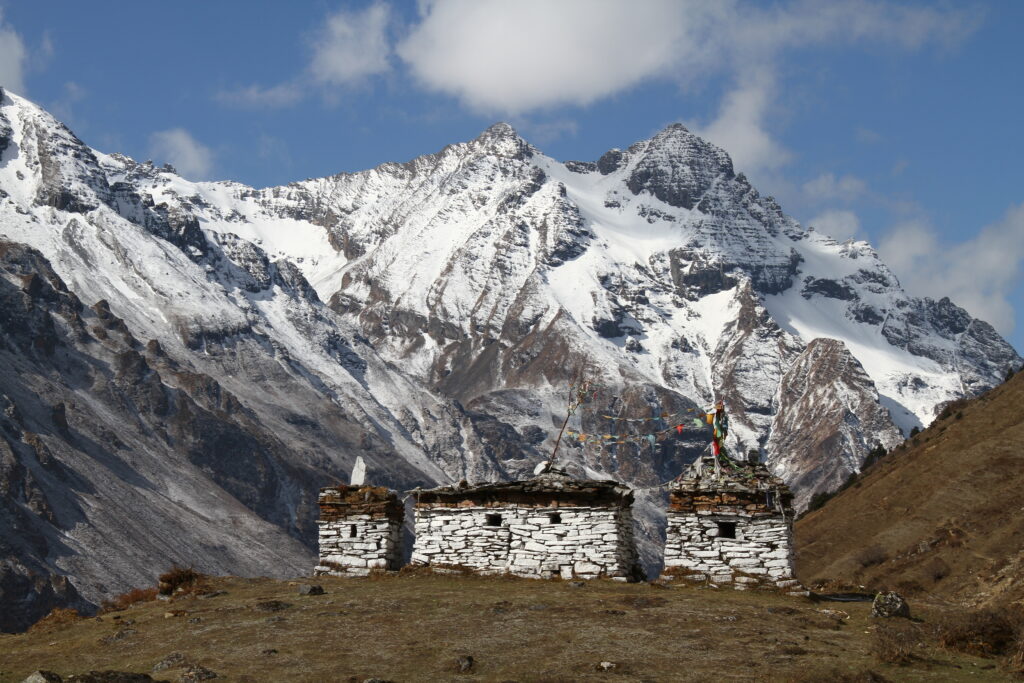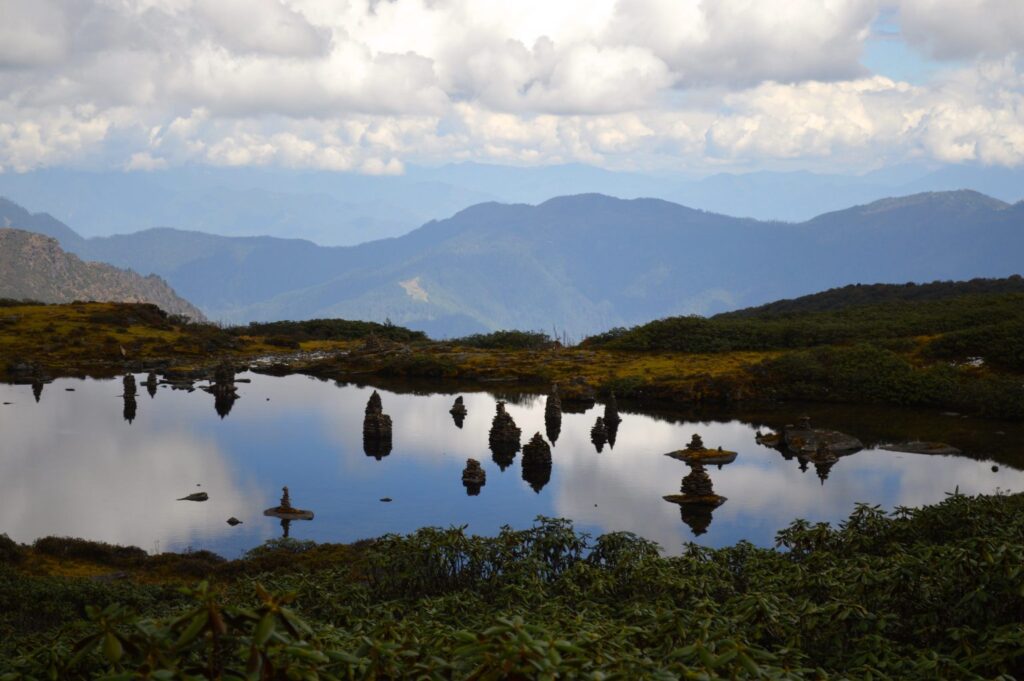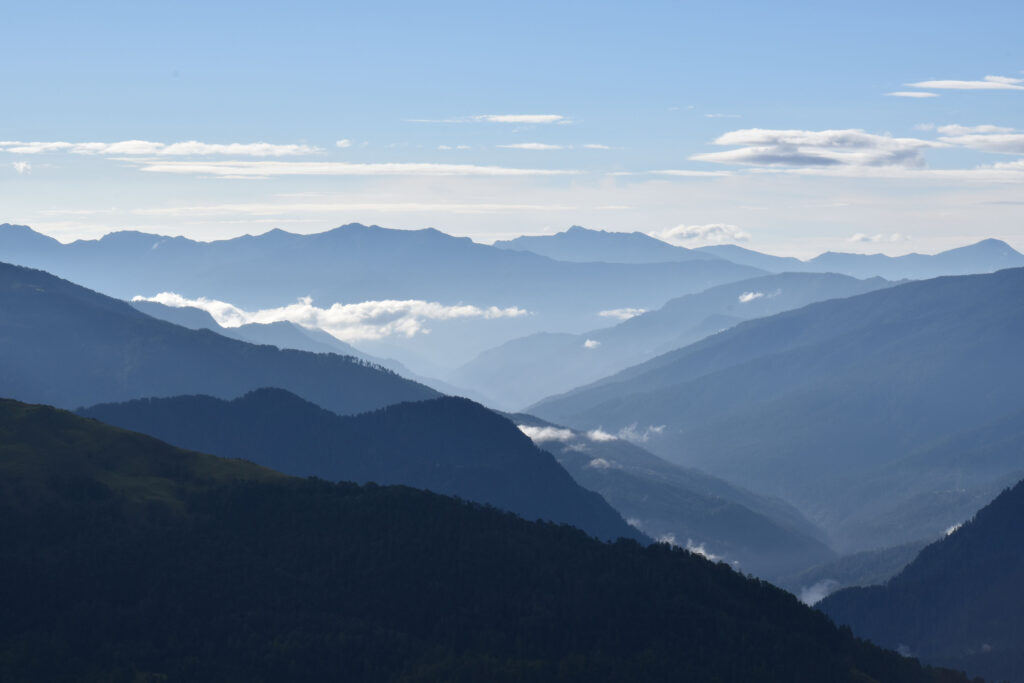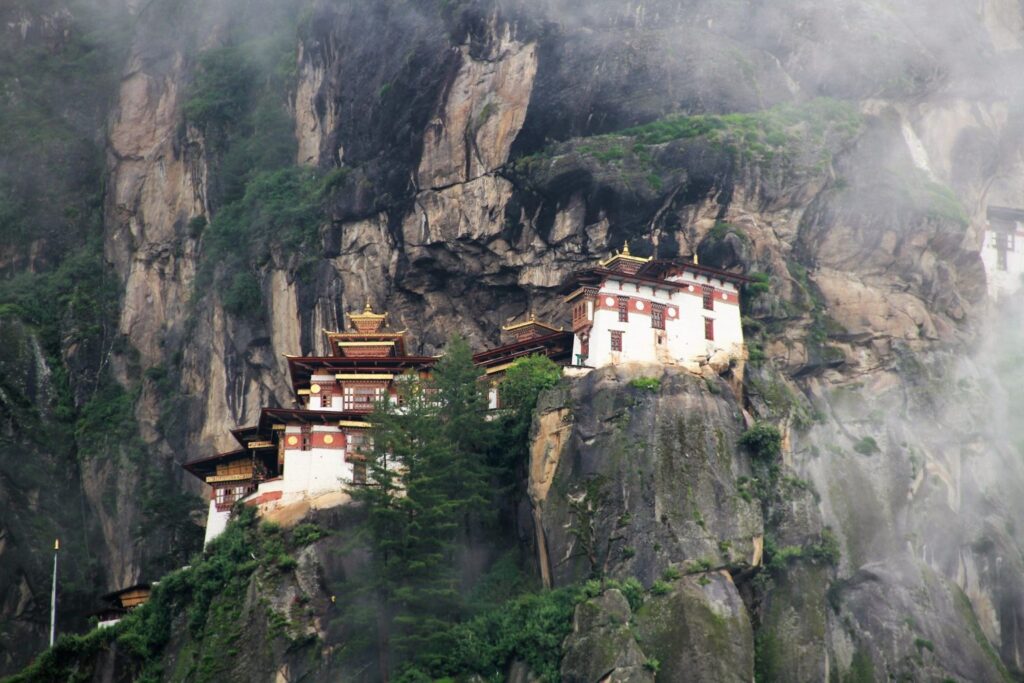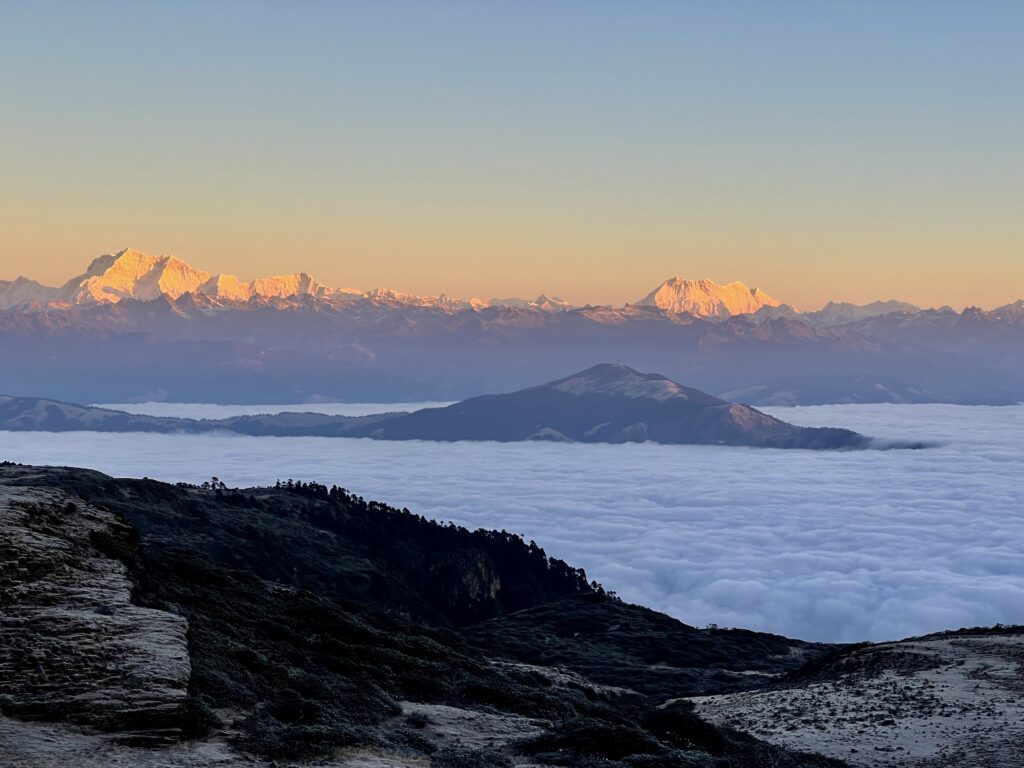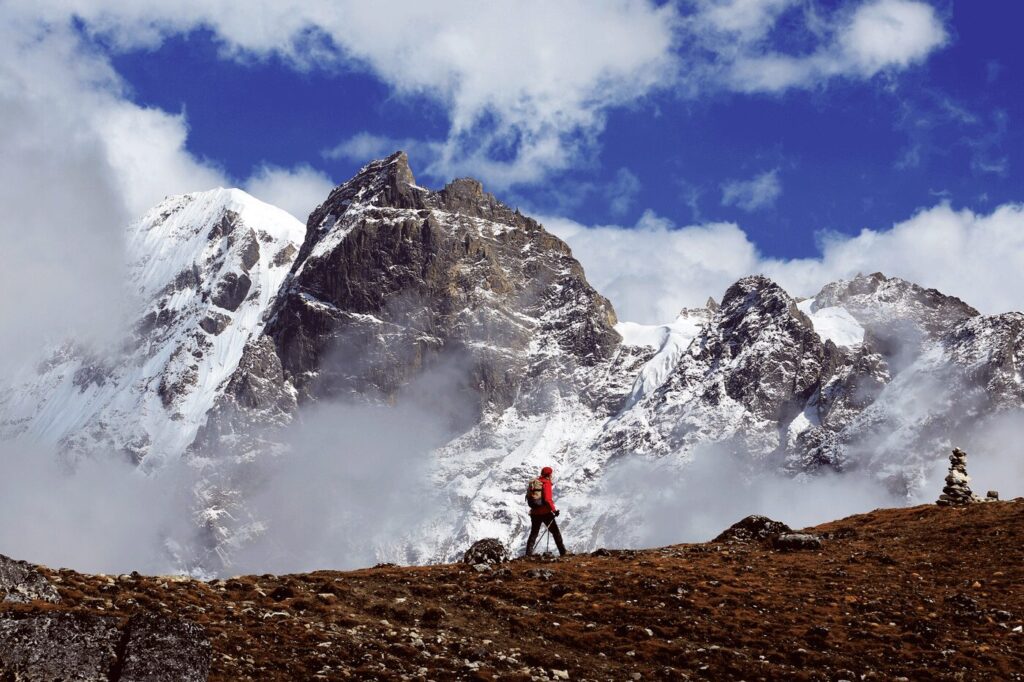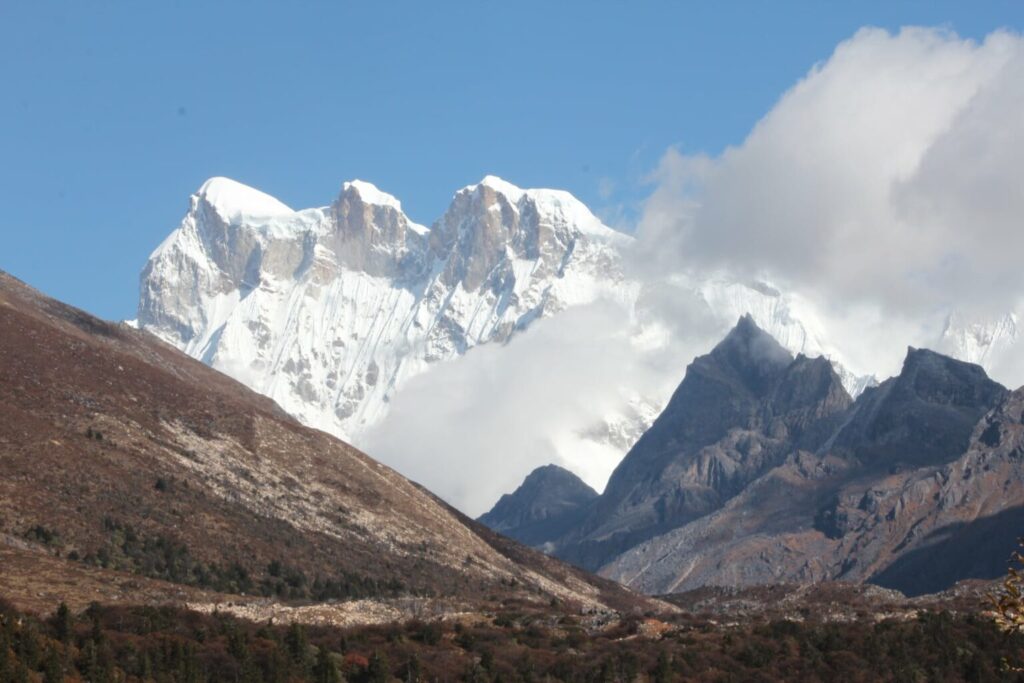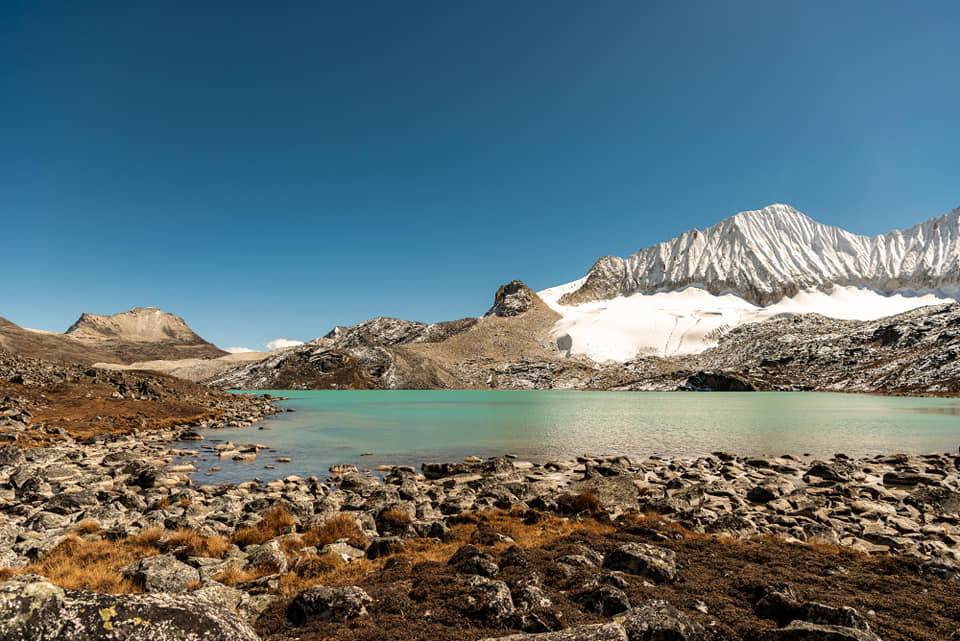Day 01: Arrive in Paro and drive to Thimphu
- Altitude in Paro: 2,300m
- Altitude in Thimphu: 2,400m
- Distance: 55km
- Estimated travel time: 1.30hrs
Your plane will land in Paro, one of Bhutan’s biggest cities. And you can catch the splendid sight of Himalayan snowcapped peaks from your plane. Our representative will pick you up and then we will drive to the capital, Thimphu. It is the only capital in the world that does not have traffic lights.
The first visit in Thimphu is the National Memorial Chorten, which was the idea of Bhutan’s Third King, His Majesty Jigme Dorji Wangchuck (1928-1972). He wished for the building to be a monument for world peace, and later it also served as a memorial to the Third King after he passed away.
Next, we will head to one of the most renowned sites of Bhutan – Buddha Point (Buddha Dordenma Statue). The 51.5m statue is the image of Shakyamuni Buddha sitting on a meditation hall, and is believed to emit an aura of peace and happiness to the world. There are 125,000 smaller buddha statues placed inside the giant gold-gilded statue.
We can walk around to experience the local life in Thimphu. The bustling city is Bhutan’s centre of commerce, religion and government. What makes it so attractive is the dynamic vibe of the streets and the juxtaposition of ancient tradition and modernity that one can find in Thimphu. Also, there are great pubs and numerous events in the evening, you will enjoy good music and tasty food at these places.
The first night you will stay at the hotel in Thimphu.
Day 02: Discover Thimphu
Today, we will first visit Changangkha Lhakhang, one of the oldest temples in Thimphu. The temple was constructed in the 12th century and located on a ridge above central Thimphu. This giant building is where parents traditionally come to get auspicious names for their newborns or blessings for their young kids from the protector Deity Tamdrin. If you wish, you can also give the resident astrologer your birth date and the monk will consult divination charts to decide which kind of protective prayer flags will benefit you.
After that, we will go to the Folk Heritage Museum and the National Textile Museum to explore more about the Bhutanese life and art. The heritage museum is built as a 19th-century rural house with rammed mud timber. Displayed inside are collections of typical household objects, tools and equipment. There are also regular demonstrations of rural traditions, skills, habits and customs as well as hosting educational programs for children organized here. The textile museum is a top choice attraction in Thimphu, a great place to learn about Bhutan’s national art of thagzo (weaving). Here you can find samples of Bhutanese traditional clothes, see the practicing of thagzo on different materials and in various styles as well.
We will have a lunchbreak and head to Jungshi Handmade Paper factory, which is only 1km from the city center of Thimphu. In the small factory, you can witness the fascinating traditional methods of producing authentic Dehsho paper. This type of paper was used by monasteries for woodblock and manuscript books and for writing prayer books. It is made from the bark of two tree species, Daphne and Dhekap trees. Some products like stationery and greeting cards are also made in the factory.
In the afternoon, we will head to the National Institute for Zorig Chusum, or also called the Arts and Crafts School, or Painting school. At the institute, there are different courses that teach about the traditional arts of Bhutan, and the discipline and skills of the young students are very impressive. Some craft demonstrations that you can see range from painting (furniture, thangkas) to woodcarving and embroidery.
Last stop today is the majestic Tashichho Dzong (Fortress of The Glorious Religion). First constructed in 1216 A.D, it went through renovations before it was finally completed in 1952 by King Jigme Dorji Wangchuck, after he moved Bhutan’s capital to Thimphu. You can enjoy the captivating scene around the edifice with beautiful gardens and green lawns.
You will stay at the hotel in the capital for another night.
Day 03: Thimphu to Punakha
- Altitude in Punakha: 1,300m
- Distance: 75km
- Estimated travel time: 3hrs
From Thimphu, we will drive to Punakha, which was the capital from 1637 to 1907. We will first reach Dochula pass on the way. At 3,050m, the pass is a favored place for visitors to have a splendid panoramic view of the 108 chortens with the setting of the Himalayan snowcapped peaks.
Upon arriving at Punakha, the first place for us to see will be the majestic Punakha Dzong (Place of Great Happiness). The edifice, as the second oldest dzong in Bhutan, has witnessed some momentous events of the country’s history. Asides from its remarkable structure and scenic surrounding, the dzong is well-known for containing the preserved remains of Zhabdrung Ngawang Namgyal, the unifier of Bhutan as well as a sacred relic known as the Ranjung Karsapani.
Just a short distance from Punakha Dzong, we will arrive at Pho Chhu Suspension Bridge for the spectacular overview of Punakha Dzong and Pho Chhu Valley. With 160m length, this is the longest suspension bridge in the country.
Afterwards, we will have an easy hike to Khamsum Yuelley Namgyal Chorten (1,500m). As the chorten is located on a ridge above Punakha valley, it offers the captivating scene of the whole area. From the suspension bridge, the trail will ascend 200m up the hill. While the walk can be a bit muddy, it will only take around 1 hour to finish. The construction is praised as one of the examples of Bhutanese architecture and the only one of its kind in the world.
Later, we will return and stay overnight at the hotel in Punakha.
Day 04: Punakha to Paro
- Distance: 125km
- Estimated travel time: 4hrs
From Punakha, we will return to Paro. While we are on the way, we will do an easy hike to Chimi Lhakhang (Temple of Fertility). From the main road, the trail will ascend only 20m, and after about 30 minutes crossing beautiful hillock fields, we can see the temple, which is at an altitude of 1,500m.
In Paro, there is also an iconic structure that we will see in the afternoon – the renowned Paro Rinpung Dzong (Fortress of The Heap of Jewels). The whole construction is a complex of courtyards, temples, offices and an accommodating area surrounded by towering walls. Sitting on a steep hillside, the dzong is a nice location to view the whole picturesque Paro valley with giant mountains and endless green landscape.
Heading to the National Museum of Bhutan (Ta Dzong), we will learn more about life in Bhutan. The extensive collections demonstrate the country’s rich culture and heritage, including antique thangka paintings, textiles, weapons and armour and many other natural and historic artifacts.
Finally, we will return to the town and spend time wandering around Paro’s lovely streets and stay overnight at the hotel in Paro.
Day 05: Bumdra trek- day 01
You will begin the Bumdra trek today. This is a short 2-day journey that will take you through various spots with stunning views.
There are two routes that lead to Bumdra monastery on the first day of trekking, and you can choose to take on Trail 1 or Trail 2.
With trail 1, you will take off from the parking area at Sang Choekor Shedra. For trail 2, you will start at the parking lot of Ragoe Guru Lhakhang. Although trail 2 will be a little shorter, the elevation will be greater.
Trail 1: Sang Choekor Shedra – Bumdra Monastery
- Distance: 7 km
- Time: 3-4 hours
- Ascent 960 m
- Camp Altitude: 3,800 m
In the morning, we will drive to Sang Choekor Shedra (2,900m), the starting point for the Bumdra trek. It is a Buddhist college, where we will visit briefly and receive blessings for a safe trek.
From the parking lot, you will follow the trail to the left, then keep climbing until reaching a forestry ridge of blue pines, oaks and rhododendrons. The ridge with payer flag is a great location to view the striking landscape of Paro and Do Chhu valleys.
Continuing, you will arrive at Choechotse Lhakhang (3,650m) after 1-2 hours of walking. The temple houses a Denpa statue, which is believed to have rescued the valley from a measles outbreak, and some 700-year-old murals.
The path after the temple will slowly go up, with the last part is steeper. But after the last elevation, you will be rewarded with the breathtaking views of the Himalayas and Paro International Airport.
You will descend for 40 minutes crossing a lush forest of larch, silver fir, and juniper before entering a large meadow with sacred chortens and fluttering prayer flags. After another 20 minutes of trekking, you will see Bumdra Monastery. The monastery was built in the 18th century against a cliff visited by 100,000 Dakinis. This monastery has the grotto where Dakinis, the Goddess of the Fairies, is claimed to have left 100,000 footprints. Dorje Phagmo, an emanation of Guru Rinpoche’s consort Yeshe Tsogyel, is the major deity here.
The camping site is located close to Bumdra monastery, at an altitude of 3,800m.
Trail 2: Ragoe Guru Lhakhang temple to Bumdra monastery
- Distance: 5km
- Estimated time: 3-4hrs
- Camp altitude: 3,800m
- Ascent: 1,100m.
After breakfast, we will drive about 20 minutes to Doteng village, then continue for another 30 minutes on a fiddle road to reach the car park of Ragoe Lhakhang. The trek will begin here and take 1 hour to reach Ragoe Guru Lhakhang (2,800m). You will climb a short distance through pine, hemlock, and oak forests and then back on a normal trail for the rest of 2 km. The site was blessed by Guru Rinpoche in the 8th century, and Drupthob Thongtong Gyalpo constructed it there in the 15th century.
Built against the cliff wall, Ragoe Guru Lhakhang is a traditional structure in Bhutanese style. There are several wonders to view at the temple, including a self-spoken statue of Guru Rinpoche, his footprint, lotus hat, and walking stick; the body of a mountain goat; the body of a vulture, etc.
According to legend, when Guru Rinpoche first arrived at this spot, he used his walking stick to puncture the ground, which caused the serpent to emerge from the lake. He covered the lake with his hat, and subdued the snake before it could flee.
The name Ragoe has an interesting story behind it. The copper statue of Guru Rinpoche at Thang Zo in Punakha was created in the 17th century by Drubthob Phuentsa Dewa, a Jinzop of Zhabdrung. But since the statue stated that his primary site was in Paro, they changed their plan. A vulture and a goat emerged and carried the status to his projected site as the people struggled to decide where it should go. The temple was thus given the name Ragoe.
You will visit the temple shortly and then proceed to hike towards Bumdra monastery. The trail climbs 200 meters above the monastery and then gradually ascends until it reaches the camp site.
Day 06: Bumdra trek – day 02: Bumdra monastery – Taktsang monastery – Parking car of Taktsang monastery
- Distance: 7km
- Estimated time: 4hrs
- Descent: 1,260m
Starting the day with a nice breakfast and stunning natural scenes at the campsite, you will be ready for today’s journey. You will trek down to the valley, crossing the lush forest of pine trees of rhododendrons and continuing on the monk’s zigzagging trail. Once on the trek for 30 minutes, look back to Bumdra for the last time.
After about an hour walking downhill, through silver pines and larch covered in lichen, you will arrive at Yoeselgang, the ‘Shining Summit,’ at 3,300m. You can view a beautiful woodblock print depicting Guru Rinpoche’s eight incarnations here. You will come to Ugyen Tshemo Lhakhang (3,280m) after another ten minutes, followed by Zangdo Pelri Lhakhang (3,300m). If you are brave, peering over the edge for the splendid sight of Taktsang monastery’s ornate rooftops perching against the cliff far below.
After a 2-hour descent back into Paro’s valley, the golden roofs and great monastery of Taktsang are visible, signaling the end of the Bumdra trek.
The trail is decorated with colorful prayer flags to the spiritual motivation to endure the hardship. You will trek for another hour, pass a waterfall and arrive at Taktsang Monastery (Tiger’s Nest). It is one of Bhutan’s most revered locations and stands on a cliff more than 3,000 meters above sea level.
Legend has it that the cave was given the name Taktshang when Guru Rinpoche is claimed to have flown here from Kurtoe Singye Dzong in eastern Bhutan on the back of a tigress, in the 8th century. Later, to tame the demons, Guru Rinpoche appeared as Guru Dorji Drolo, a wrathful form. The monastery is one of the thirteen Taktshangs that are predicted to be constructed in the Buddhist world. Several Lamas of all traditions witnessed Guru Rinpoche’s vision at this revered site in Paro Taktsang.
Taktsang Monastery was completed in 1694. The monastery is home to numerous temples with sacred statues of Guru Rinpoche’s eight incarnations, Tshepame Yabyum, and a Pelgi Singay bone relic. Plus, its location offers an astounding view of the majestic Himalayan mountains and verdant valleys.
Moreover, every Bhutanese is expected to complete the pilgrimage to the Tiger’s Nest at least once in their life. You will have lunch at the Taktsang cafeteria before heading towards the Paro valley floor. A fair number of steps are inclines on the initial return trip to the parking lot. Once you’ve passed a viewpoint, the rest of the route is entirely downhill. It will take 6-7 hours in total.
You will afterwards go to Kyichu Lhakhang. The structure is one of Bhutan’s oldest and most sacred temples, and it is located in Lango Gewog of Paro. Kyichu Lhakhang was one of the 108 chortens that Tibetan King Songtsen Gampo built in the seventh century to fend off a powerful ogre. The main relics are statues of Jowo Jampa (Maitreya) and Sakyamuni.
You will have a special meal with a Bhutanese family in the late afternoon. This is the most authentic way to interact with and learn about local culture, and you may spend time with the friendliest people. A hot stone bath will also be offered to you. Bhutanese people relax in this way after a long day of work. They mix herbs with the water, which interact with the stones’ minerals and are very good for you.
You will spend the last night at the hotel in Paro.
Day 07: Depart Paro
After breakfast at the hotel, your guide will take you to the airport for flight to your onward destination. It is time to say ‘Tashi Delek’ (goodbye and good luck) and hope to see you again!

